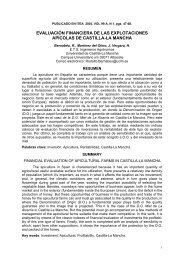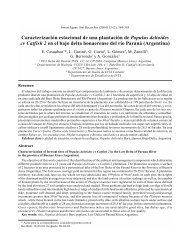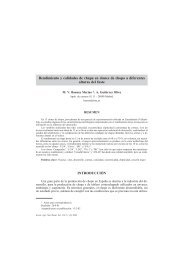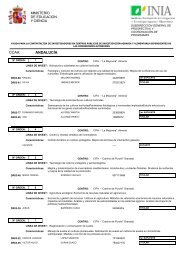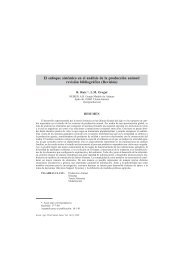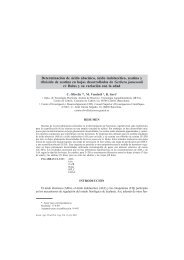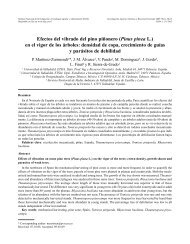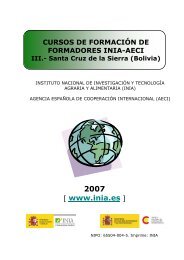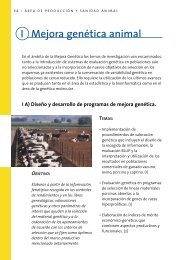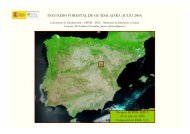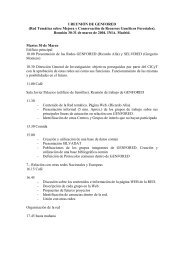Spanish Journal of Agricultural Research Instructions for authors - Inia
Spanish Journal of Agricultural Research Instructions for authors - Inia
Spanish Journal of Agricultural Research Instructions for authors - Inia
Create successful ePaper yourself
Turn your PDF publications into a flip-book with our unique Google optimized e-Paper software.
112 Span J Agric Res (2007) 5(1), 111-115<br />
Genus is spelled out completely the first time an organism is mentioned in the abstract, the text, and in<br />
every figure and table. If you are discussing several different species within a genus, so that the genus is the<br />
same <strong>for</strong> each species mentioned, spell the genus + species out in full the first time each new species is<br />
mentioned, even if it seems redundant. After the first time, use the genus abbreviation with a period. Genus<br />
and species are always italicized. Do not italicize «spp.» or «sensu stricto» or «sensu lato» that may follow<br />
genus and species. Genus is italicized when it appears alone (i.e., Plasmodium infections).<br />
The Latin binomial or trinomial and authority must be shown <strong>for</strong> all plants, insects, pathogens, and animals<br />
at first listing (e.g. Lycopersicon esculentum Mill). Both the common and chemical name <strong>of</strong> pesticides must be<br />
given when first mentioned. For example: «Atrazine (2-chloro-4-ethylamino-6-isopropylamino-1,3,5-triazine)<br />
was most persistent...» Identify soils at the series and family level, or at least the Great Group, at first mention.<br />
The first time that botanical cultivars are mentioned these should be marked in single inverted quotation<br />
marks or the term cultivar or the abbreviation cv. should be used: (e.g.: ‘Royesta’ tomato or Lycopersicum<br />
esculentum Mill cv. Royesta). After, this can be referred to as Royesta tomato or Royesta cultivar.<br />
Animals (breed, sex, age, body weight), diets, surgical techniques, measurements and statistical models<br />
should be written in a clear and detailed way.<br />
Manuscript preparation<br />
The following layout is recommended:<br />
First page. The first page must include: 1. Title <strong>of</strong> the work. 2. Short title. 3. Name(s) <strong>of</strong> author(s), being<br />
the corresponding author marked with an asterisk (*). 4. Name and full postal address <strong>of</strong> the institution(s). 5.<br />
E-mail address and telephone number <strong>of</strong> the corresponding author. 6. Number <strong>of</strong> figures and tables. 7. Authors<br />
who are members <strong>of</strong> Sociedad Española de Agroingeniería or Sociedad Española de Ciencias Hortícolas must<br />
indicate the affiliation. 8. Topic. As the journal is multidisplinar, <strong>authors</strong> are invited to select the principal topic<br />
<strong>of</strong> the submitted paper from the following: agricultural economics - agricultural engineering - animal health and<br />
welfare - animal nutrition - animal production - animal reproduction - apiculture - aquaculture - biodiversity and<br />
genetic resources - biotechnology - breeding and genetics - environment and ecology - food science and technology<br />
- <strong>for</strong>ages and pastures - plant health and protection <strong>of</strong> crops - plant physiology - plant production - rural<br />
development - soils, fertilization, irrigation and watering - other (suggestions are welcomed).<br />
Text <strong>of</strong> the article. This should contain the following sections: Abstract and Additional key words in English.<br />
Title, Abstract and Additional key words in <strong>Spanish</strong>. Introduction. Material and Methods. Results. Discussion<br />
(avoid to join Results and Discussion in a single section). Acknowledgments (if any). References. Tables and<br />
figures (one per page). If an appendix is needed, it comes after the references.<br />
— Title <strong>of</strong> the work. This must be clear, short and concise, avoiding terms such as «Studies about...»,<br />
«Observations...», «Contribution to...» The title should preferably not exceed 25 words. The short title <strong>of</strong> the<br />
work, used in the heading <strong>of</strong> the pages <strong>of</strong> the printed article, should not exceed 90 characters (letters plus spaces).<br />
— Abstract. With a maximum <strong>of</strong> 250 words, must be specific, not containing references. It will include<br />
the objectives, methods, results, and main conclusions. Crops or organisms involved must be identified, as well<br />
as soil type, chemicals, or other details important to interpretation <strong>of</strong> the results.<br />
— Additional key words. A maximum <strong>of</strong> seven. They should not repeat words appearing in the title.<br />
— Abstract in <strong>Spanish</strong>. This will include translation <strong>of</strong> the title and the key words.<br />
— Introduction. This should contain sufficient in<strong>for</strong>mation about the background to the work so that this<br />
can be placed in context with other research, <strong>for</strong> the reader to understand the objectives proposed and evaluation<br />
<strong>of</strong> the results. It should not be too generalised or too detailed. It should conclude with one or two sentences that<br />
define the objectives and the essence <strong>of</strong> the article.<br />
— Material and Methods. Sufficient in<strong>for</strong>mation will be given to enable the experiments to be repeated.<br />
For routine methods, a brief description and a literature reference will be sufficient. New methods must be<br />
described in detail and, in the case <strong>of</strong> little used chemical products or equipment, the manufacturer’s name and<br />
address should be given.




